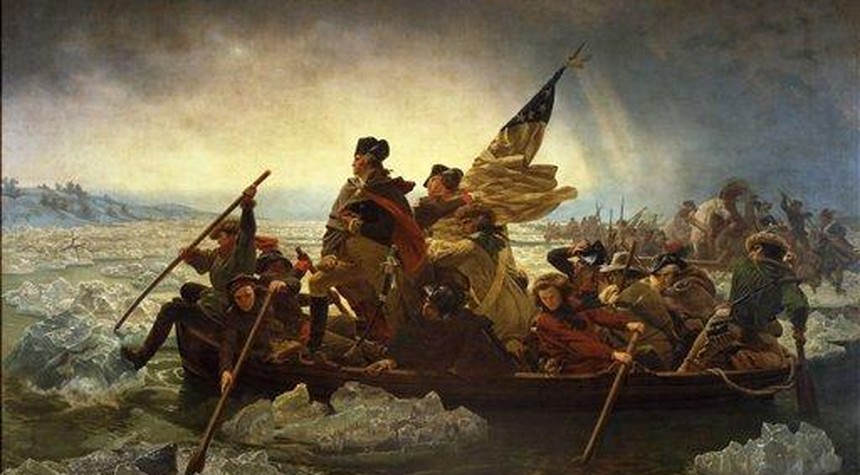Can You Spare $20 Million?
Can You Spare $20 Million?
Iconic Painting 'Washington Crossing the Delaware' up for Auction

It’s the most parodied piece of American art in history. The depiction of the future first president of the United States standing proudly on the prow of a Durham boat staring steadfastly across the Delaware River to the far shore while ice floated in the water and men struggled to make headway against an icy current has been depicted by everyone from Star Wars characters to the Muppets.
Emanuel Gottlieb Leutze’s “Washington Crossing the Delaware” has a deserved ranking as one of the most beloved pieces of art in American history. Originally there were three identical depictions of the event. The first replica was given to a museum in Bremen, Germany. It was destroyed by allied bombers in World War II.
A second depiction — a huge 12.4 x 21.25 feet — is the centerpiece of the Metropolitan Museum of Art’s American Wing.
The third depiction is just 3 x 6 feet and hung in the White House for decades. It’s this replica that will go up for sale by Christie’s Auction House in May.
“A German-born American immigrant, Leutze was also a staunch abolitionist and in ‘Washington crossing the Delaware’ he deliberately included a variety of the figures that make up the melting pot that formed the American nation,” said Kestenman.
She pointed out a Black soldier, another soldier wearing a Scottish bonnet, and moccasins and buckskin clothing suggesting the American West and Native Americans.
Only a left-wing, artsy-fartsy critic would take the painting to task for being “historically inaccurate.”
Most obviously, if Washington had been perched on the boat’s edge as depicted, he would have fallen into the icy water and could well have drowned. This is hardly a new revelation. An NPR report from 2002 by Ina Jaffe goes through some of Leutze’s historical flaws, and begins with this most glaring one. It’s not really the fact that Washington is standing up that is incorrect—it’s most likely that everyone would have been standing given that the boat would have been both flat and soaked with frigid water. Rather, it’s his precarious pose that is at issue. Also, while Washington appears as the aged, stately figure that many today imagine, at the time of the battle he was a spry 44, not the elderly, greying man Leutze captures.
The best art speaks to each of us individually. The painting speaks volumes about what was at stake and what the rebels were willing to do to win their independence.
Recall that the American army had been pushed around mercilessly by the British the previous summer. Booted out of New York and New Jersey, they escaped across the Delaware River where Washington’s army began to disintegrate.
To make matters worse, the enlistments of thousands of Continental soldiers were going to be up before the first of the year. Washington promised bonuses for any soldier who re-upped — an irony since most of them hadn’t been paid in the first place.
But he was persuasive enough to convince a few thousand veterans to re-enlist. They formed the basis for Washington’s strike force as they prepared to execute the most daring military plan in U.S. history.
The attack on Trenton was a no-brainer in the sense it that was the most isolated garrison in New Jersey, and Washington’s excellent intelligence network told him that the Hessians were contemptuous of the rebels and didn’t take proper precautions.
After that success, Washington turned his attention to Princeton.
Crossing the River again, he confronted General Cornwallis whose 1500 troops had occupied a position between Washington and Trenton. With darkness falling, Washington left 400 men to tend campfires, giving Conrwallis the impression he was staying put while taking the bulk of his army clear around Cornwallis to attack a garrison headquartered at Princeton.
At first, the battle went badly for the Continentals. As the British surged forward and threatened to rout Washington’s army, he spurred his horse forward, rallied his men, and with bullets flying all around him, led the troops to a decisive victory. Then, before Cornwallis could cut off his retreat, he led his force to Morristown where he went into winter quarters.
Quite a bit of soldiering for an “amateur.”
The historical inaccuracies in the painting don’t matter. What matters is the miracle Washington wrought at Trenton and Princeton with the war all but lost and American independence slipping away.
Anyone got a spare $20 million to give me so I can buy it?




Post a Comment